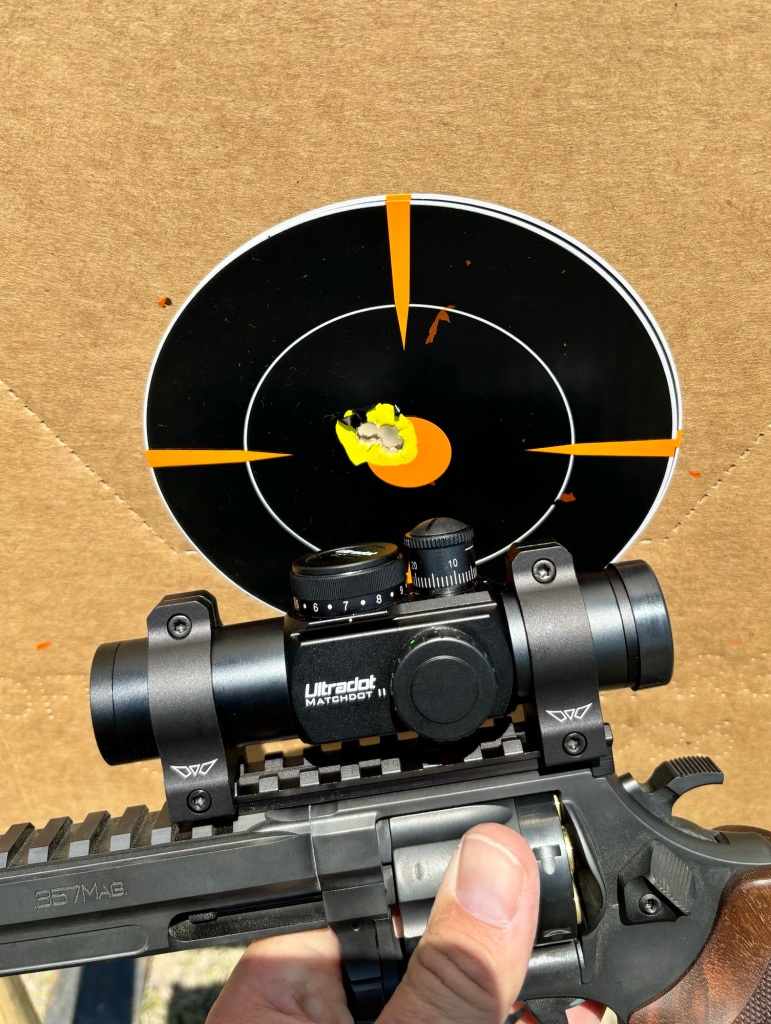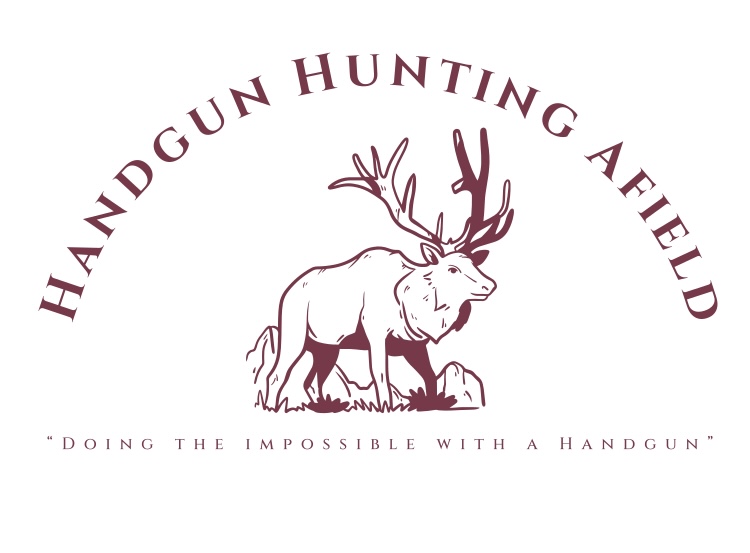Over the years of handgun hunting I have used everything from iron sights, to magnified optics, to dot sights.
Like most I started with iron sights. I changed blades, sight designs, colors, and so on to get a better sight picture. As I progressed down this path I was always searching for more. That more I was searching for was a better sight picture on the game animal which would allow me to be more accurate, shoot quicker, and shoot farther.

The first change from iron sights was magnified optics. Handgun scopes have a longer eye relief so you can shoot them at arms length. I used various handgun scopes over the years. They do have an advantage for punching tiny groups and for longer distance vermin shooting; they also have many limitations. The longer eye relief can be difficult to work with in field positions where you end up unable to fully extend your arms. In addition they can be more difficult to hold steady enough to shoot without artificial support. In general I found the 2x scopes to be the most useful for field shooting in various positions. If support was available the 4x greatly increased my ability to be accurate. Optics above 4x I found to be impractical without a very stable artificial support.

Along with magnified optics I used various forms of dot sights over the years. There are two basic designs in the dot sight world, reflex and tube. Reflex sights have a smaller footprint than the tube sights. Reflex sights can often times replace the rear sight on a handgun and take up very little space whereas a tube sight will mount more like a pistol scope using rings and a base.

Dot sights do not have magnification which will make them easier to hold steady shooting free hand. The dot itself is illuminated and will draw the eye making them fast to locate on the given target. They also offer an extremely wide field of view that is less obscured than even iron sights. The down side with all dot sights is the fact that they require a battery and battery life becomes a concern. Even with that, these batteries are small and affordable. Carrying a spare and also changing out your battery before a hunt isn’t a major burden.
Over the last few years I began making the switch from magnified optics to dots entirely for a few reasons. The main one is handgun scope technology has been stagnant for decades while dot sights continue to advance. As the quality of the glass and the electronics continued to advance I started seeing less difference in my field shooting abilities with a hunting handgun using a pistol scope vs dot sight. Furthermore as my hunting shifted from eastern tree stands to western spot and stalk I needed an optic that I could shoot in all field positions. A magnified optic is extremely difficult to shoot free hand and when you go prone you often times do not have enough eye relief to have a proper field of view. The last but not the least important reason is light transmission. With a handgun scope you more often then not loose the last half hour of hunting time due to the fact they do not gather light very well. The dot sights get me right up to last light with few exceptions.
As I made the change to all dot sights I bounced around in optics design and brand. I used reflex and tube sights and kept trying them out in the field. For a reflex I used the Trijicon SRO a good bit. This sight performed well and I took a lot of game with one. The battery life and ruggedness were great. The one draw back I had with reflex sights was that they would accumulate debris in the “lens pocket” and that could be difficult to remove. If that debris happened to be snow or water the sight could be rendered useless as the projected dot would blur and become difficult to see.

I also spent quite a bit of time with tube sights. I have used both Aimpoint and Ultradot tube sights. With a tube sight you mount it with rings just like a scope. Tube sights have a couple distinct advantages over a reflex. Since they have a tube for you to look through most people tend to be able to center the dot faster than a reflex design with less training. Being of a sealed design we do not have to worry as much about debris or water obscuring the dot in the sights and if it does they are easier to clean or clear the debris.

As I had more time handgun hunting and shifted to dot sights I began to form a more solid personal opinion on what sights worked better in the field. Although I like the compactness of the reflex sight and the fact I can easily modify a holster to fit them, I found myself using just chest rigs for hunting which made this a moot point. The tube style began to shine for field use. Being sealed from weather and environmental effects was a big plus, the tube helping me focus down the sight and to find the dot more quickly, and the sight intensity settings were more adjustable which helped in various lighting conditions all factored into my choice of a tube over a reflex.

I ran two major brands of tube sights over the years, Aimpoint and Ultradot. Aimpoint is a quality made sight that is very rugged, has great glass, and works well but is extremely heavy for what it is. This added weight isn’t a big deal on a rifle and their military/LE market enjoys their robustness but for the handgun hunter we need less mass. When the firearm begins to recoil the optic, rings, and base all try to remain still until the movement of the gun forces them to come along in motion. This increased resistance to movement caused by the heavier mass can lead to screw, ring, base, and ultimately optics failure.

Ultradot has all the features of the Aimpoint tube sights that matter to me as a handgun hunter with one major difference; it’s much lighter! Ultradot uses Japanese optical glass which gives me a clear picture through the sight, good intensity adjustment, and is capable of taking the recoil of a big bore handgun. I have used Ultradot sights for about 20 years in the field with the last seven or so years hunting solo in the back country of Wyoming for all manors of big game. They work and work well for me as a handgun hunter.
Now that we know how I landed on Ultradot as my optic of choice in the field another question that comes up is how far can you shoot with a dot sight and what are the limitations?

We know from the metallic silhouette games for handgun shooters that 200 yards has been deemed reasonable for a handgun for decades. This is further supported by the competition I host, Handgun Hunter’s Competition where we shoot realistic size targets with hunting revolvers to roughly 200 yards. Distances up to and beyond 200 yards are not unreasonable with a dot sight. In fact I have posted many videos and pictures over the years of me shooting that far; it just takes good solid practice. Distance is just drop and drift.
When shooting a dot sight for extreme accuracy we have to focus on the right thing. Your eyes are only capable of focusing at one distance at a time and for this just like with iron sight or a magnified optic it needs to be the reticle or dot. Your dot should be in perfect focus when you are lined up on the target and the target should be slightly out of focus or blurry. If you have an astigmatism the dot may look a little like a star or fuzzy and that’s fine; we just need it consistently focused upon with each shot. It will help with your astigmatism to turn the dot intensity setting down as low as possible. Personally I like the dot to appear almost transparent.

Now to adjust for distance we have a little math to do. You should have a range finder with you while hunting so you will know the distance, if you study your game some you will know the back to brisket measurement (top of the back to bottom of the chest), you know your dot’s MOA measurement, and you should know your ballistics. All we have to do is factor our bullet drop for the given distance. Knowing the back to brisket measurement and the dot size you just have to hold correctly for the bullet drop. You can do the math on where to place the dot on the animal factoring the animal size, dot size, and ballistics.

Ultradot has another unique feature on the Match Dot 2, a target turret. If you would rather dial your drop you can and the turrets repeat as they should.
You will obviously need to practice the above on the range prior to your hunt but it is more than doable. You should never feel under equipped for a hunt using a dot.
Dot sights are where I have landed for my choice in optics and Ultradot fits the bill for me as a best pick for the handgun hunter. You should give one a try if you haven’t already!
Do you want to give Ultradot a try? I can help!



Leave a comment